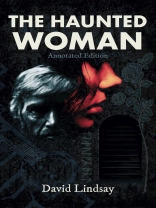All that prevents Isbel Loment’s marriage to insurance underwriter Marshall Stokes is finding a settled home for her aunt, with whom she has been living these past nine years, drifting between a series of hotels.
Marshall suggests Runhill Court, whose owner, Henry Judge, may be interested in selling after the death of his young wife. But the house comes with a mystery attached: a staircase is said to appear to certain people at certain times, but they can never remember what happens when they ascend.
On her first visit to the house Isbel sees the stairs. Ascending them, she finds three plain doors. Through the first she sees herself in a mirror, with all the potentialities of her deepest nature written plainly upon her face – all that her coming marriage to the shallow Marshall will leave unfulfilled.
Descending the stairs, she forgets it all, but is left with a troubling need to understand what happened to her, and to fulfil her truer, ‘tragic’ nature.
Lindsay’s second novel questions the possibility of the deepest fulfilment in a world whose very nature seems to work against it – and which may lead those seeking it to test their relationships, values, and even their very notions of themselves.
This edition of David Lindsay’s The Haunted Woman is extensively annotated, placing the novel in its historical, cultural, and biographical context, and firmly within the larger body of Lindsay’s work as a writer.












